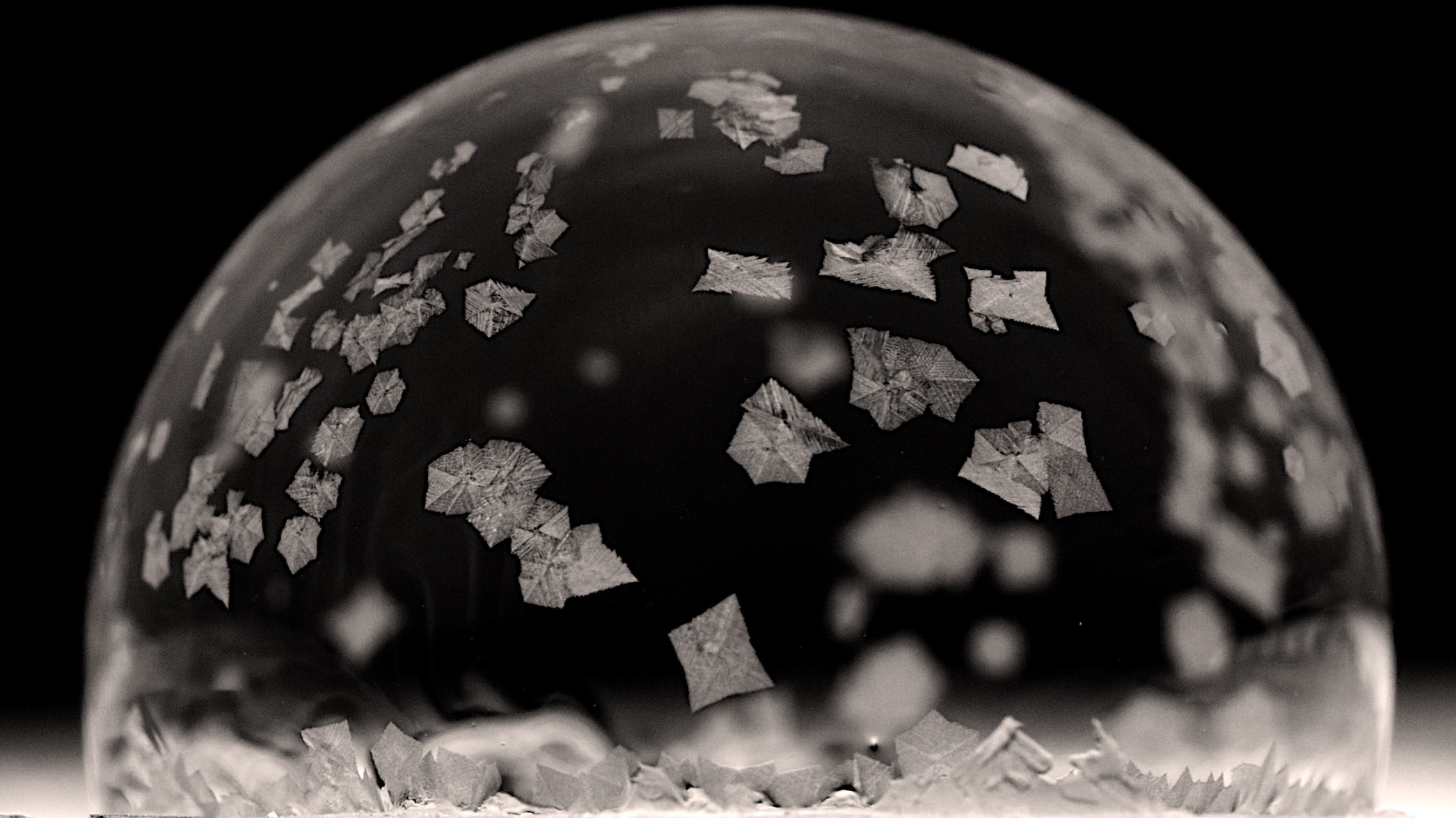The physics of freezing soap bubbles is cooler than you’d think
Freezing soap bubbles look like snow globes. This whimsical effect could help us improve biological freezing techniques—and is incredibly fun to watch.

A bubble freezing on a block of ice inside of a freezer. Image Credit: Farzad Ahmadi and Christian Kingett
If there’s anything more mesmerizing than iridescent swirls dancing across a soap bubble, it’s the sight of icy stars whirling around that bubble as it freezes.
So when a YouTube video of a bubble freezing made its way to mechanical engineer Jonathan Boreyko and his team at Virginia Tech, they weren’t just awed. They wanted to understand the physics behind the stunning display of swirling ice crystals.
“A lot of things in research are more motivated by a desire for truth or beauty,” Boreyko says, “like just trying to understand a new and mysterious thing.”
The team’s study, published last month in the journal Nature Communications, reveals the physics of the “snow globe effect,” a phenomenon that causes hundreds of tiny ice crystals to float across a bubble’s surface and freeze simultaneously in a whimsical display.
What Boreyko and his team set out to determine was where the hundreds of small ice crystals in the snow globe effect come from. Typically, when a relatively small quantity of a liquid freezes—like when water turns into an ice cube—the freezing process begins from a single point of origin. That point creates an expanding boundary between frozen and unfrozen liquid called a freeze front. As the freeze front expands outward, it cools the remaining liquid, causing it to change phase and become ice.
But in bubbles, Boreyko and his team noticed, this process can be different. When the researchers froze some bubbles in a walk-in freezer and took photos and videos of them, they saw what looked like hundreds of freeze fronts floating simultaneously across the bubbles’ surfaces.
To look more closely at the physics behind the multitude of freeze fronts, the team developed a mathematical model to simulate bubbles freezing. The modeling, Boreyko says, was the hardest part. “Once all the experiments were done, it took over a year to fully model and understand the physics behind the stuff we were seeing,” he says.
What the team discovered follows the fundamental process of freezing itself: The moment a liquid freezes, it gets slightly warmer. This is because as a liquid’s molecules rearrange and fuse into a solid, excess energy is released in the form of heat, called latent heat.
When a bubble is in a freezing environment and lands on a cold surface, the first thing to freeze is the bottom of the bubble. As this freeze front expands, it releases latent heat into the adjacent liquid surface of the bubble. This warms the water at the edge of the freeze front ever so slightly and causes it to flow toward the top of the bubble.
As more latent heat is released, the water flow grows stronger. This puts stress on the freeze front and causes extremely tiny ice crystals to break off and slide across the bubble’s surface. These crystals then begin to grow simultaneously, giving the impression that there are multiple freeze fronts forming at once.
“It actually is only one freeze front,” Boreyko says, adding that the cold surface provides a point of origin to start the growth of ice crystals.
“This paper was not about ice, really. It was more about liquid flow,” says Kenneth Libbrecht, a physicist at Caltech specializing in ice crystals and snowflake formation who was not involved in the study. The study’s unique finding, he says, is that freezing creates liquid flows on the surface of bubbles that create a feedback loop, which enhances the freezing process itself.
This new understanding of the snow globe effect could someday help experts engineer better ways to freeze things, including biological material like human tissue.
The progression of the "snow globe effect" in three images. Image Credit: Farzad Ahmadi and Christian Kingett
Currently, the low-temperature freezing of human tissue, called cryonics, is mostly limited to freezing small tissue samples or single cells, says Steven Van Sciver, a professor studying cryogenics and cryonics at Florida State University who was not involved in the study. Larger samples, such as full organs, he says, become damaged during the freezing and thawing process.
“Most of what you see in Star Wars and Star Trek and Hollywood is things like freezing people and bringing them back to life,” Van Sciver says. “And most of it is a hoax.”
But, to researchers looking for better ways to freeze things, bubbles present a unique opportunity, he says. “Understanding how these crystals are formed in very thin bubbles and how they move around could be helpful in understanding biological freezing done with cryogenics.”
But Boreyko says his team didn’t have an end use in mind when they started this project, just a desire to understand what they were seeing.
“People are always thinking about applications,” Libbrecht says. “I think that’s the wrong way to think about it. In this case, the research is very inexpensive....It’s OK to spend a little bit of money trying to understand what’s going on around you.”